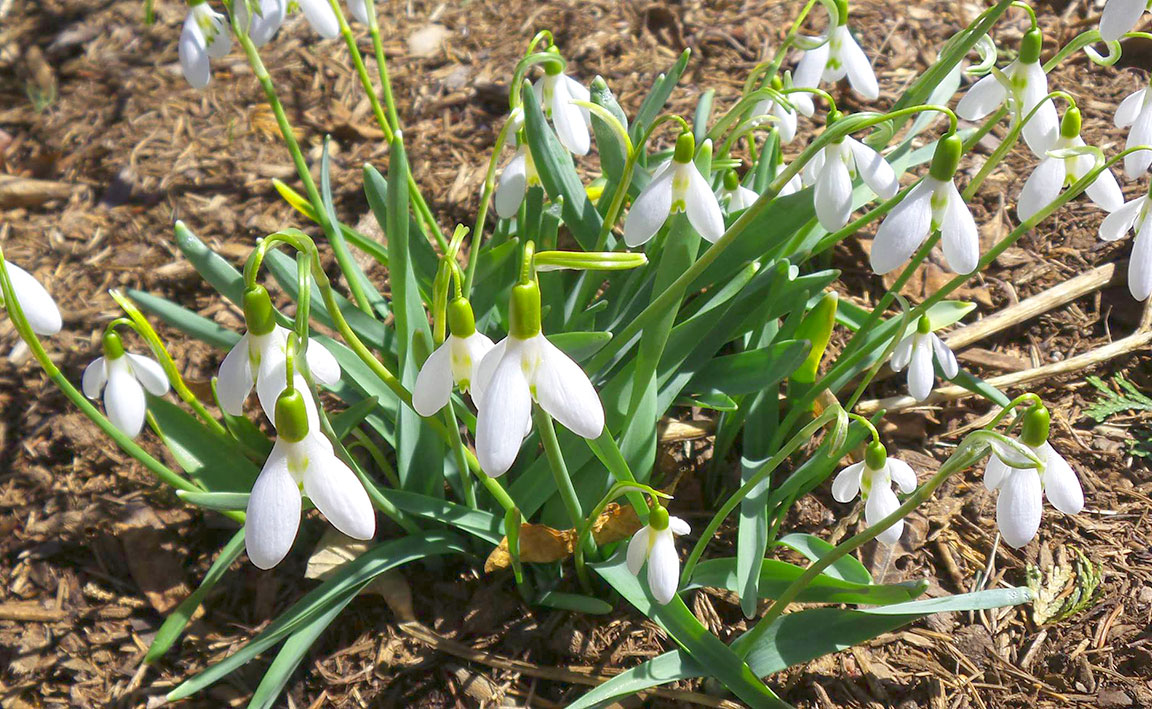
Maine Home Garden News — March 2024
In This Issue:
- March Is the Month to . . .
- Cultivating Change: The Remarkable Journey of Maine State Prison’s Garden Program
- Using Canned Goods in Cooking
- The Japanese Hori Hori: One of the Most Versatile Garden Tools You’ll Own
- Backyard Bird of the Month: Mourning Dove
- Help Stop Invasive Species during National Invasive Species Awareness Week
- Real-Life Examples of How to Handle Kitchen Scraps
- Maine Weather and Climate Overview (March)
March Is the Month to . . .
Originally published in the March 2001 Maine Home Garden News by Kate Garland
Pay it forward by purchasing a Community Supported Agriculture (CSA) share.
Farmers offer a wide range of mutually beneficial partnerships with their customers to help keep farms sustainable through the slower winter months and to keep customers filled with delicious fresh produce throughout the season. Visit the Real Maine website’s Ways to Purchase Maine Products page and scroll down the page for more information on debit-style and farmer-select CSA programs.
Prune select woody plants.
March is a great time to put those freshly sharpened pruners to work because it’s easy to see where branches are crossing, damaged, or dead. For more information, view Pruning Ornamental Trees (YouTube) and check out UMaine Cooperative Extension Bulletin #2169, Pruning Woody Landscape Plants.
Make a twiggy trellis.
These homemade garden features are both beautiful and long-lasting. Revisit this pictorial article from a previous Maine Home Garden News issue, showing step-by-step instructions.
Get a jump start on spring by forcing branches indoors.
Forsythia and crabapple are common favorites for this spring tradition, but you can savor glimpses of warmer days ahead by placing any fresh woody branch cuttings in water indoors. Not all branches will produce flowers, but they should all eventually leaf out. Try a few different options; you might be surprised by what you see!
Check out the calendar of apple orchard management activities and plan ahead for managing insects and diseases.
Consider adding ferns to your landscape this spring.
As the snow melts, I always appreciate seeing the steadfast vibrant green of marginal wood fern and Christmas fern soaking up all the spring sunshine, before the deciduous canopy begins to cast shade. Ferns are hardy, diverse, and well-suited for some of the more challenging conditions in our landscape. To learn more, visit the Wild Seed Project website.
Visit your local maple syrup producer for a sweet taste of Maine.
Maine Maple Sunday Weekend is set for March 27 and 28, 2024, but many producers are welcoming visitors over several weekends to minimize crowds. Be sure to check out their website, Real Maine, and social media before visiting to find out about protocols and hours.
Here are some seeds you’ll want to start indoors*:
- See Bulletin #2751, Starting Seeds at Home
- Early March: onions, leeks, shallots, spinach, parsley, foxglove, verbena, delphinium, dianthus
- Mid-March: cabbage, celery, kale, kohlrabi, blanket flower, hollyhock, hibiscus, petunia, salvia, snapdragon, stock
- Late March: lettuce, artichoke, broccoli, cauliflower, eggplant, Swiss chard, ammi, calendula, cardoon, globe flower, bee balm, statice, strawflower, sweet pea
*In coastal Maine, plant 10-14 days earlier. In northern Maine, plant 10-14 days later.
Starting Seeds at Home with UMaine Extension (YouTube)
Cultivating Change: The Remarkable Journey of Maine State Prison’s Garden Program
By Rebekah Mende, M.S. Food Systems and Society Vocational Trades Instructor Maine State Prison
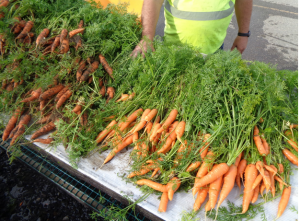 In 2016, then Warden Liberty (now Commissioner) requested that yard space at the Maine State Prison (MSP) be cultivated for vegetable production. In its infancy, the Garden Program was managed by a security officer who supervised residents while they transplanted donated vegetable starts using a plastic mug and a watering can. Fast forward to 2024 and the Garden Program has grown in size and production. In 2023, the MSP gardens produced 19,625 pounds of food using reduced tillage and sustainable garden practices. This is the abridged story of how some men in orange are growing a food revolution inside a maximum-security men’s prison. My name is VTI (Vocational Trades Instructor) Rebekah Mende and I have had the privilege of working with midcoast Maine’s incarcerated community since 2018.
In 2016, then Warden Liberty (now Commissioner) requested that yard space at the Maine State Prison (MSP) be cultivated for vegetable production. In its infancy, the Garden Program was managed by a security officer who supervised residents while they transplanted donated vegetable starts using a plastic mug and a watering can. Fast forward to 2024 and the Garden Program has grown in size and production. In 2023, the MSP gardens produced 19,625 pounds of food using reduced tillage and sustainable garden practices. This is the abridged story of how some men in orange are growing a food revolution inside a maximum-security men’s prison. My name is VTI (Vocational Trades Instructor) Rebekah Mende and I have had the privilege of working with midcoast Maine’s incarcerated community since 2018.
Using roughly two acres of inner perimeter yard space, the men at MSP have been growing vegetables, fruits, and ornamental flowers. Eighty percent of the food that is produced is consumed by MSP residents. The remaining 20 percent is donated to our local food insecurity partners to be shared with the community. Flowers are grown for both their beauty, and also to share with local community partners to be distributed to those who will enjoy them). In the summer months, the Monarch butterflies can be seen fluttering about between the zinnias and Asclepias that pepper the walkways or “miles” as they are referred to in prison.
I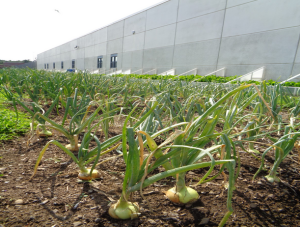 n 2017, a former University of Maine Cooperative Extension faculty member began to offer the Master Gardener Volunteer Program at the prison. To date, over 100 residents of MSP have completed their certification and are now Master Gardener Volunteers. Their certification gives them access to volunteer in the gardens during their stay at the facility and also provides a recognized endorsement of their gardening knowledge that can help with employment upon their release. In 2023, MSP was invited to join the Cooperative Extension in a pilot of their Horticultural Apprenticeship Training. Having a wonderful partnership with the Extension has proven to be extremely beneficial for us as it provides us with expert guidance when needed, nationally recognized credentials for our population, meaningful relationships with outside faculty, and strength in community allyship.
n 2017, a former University of Maine Cooperative Extension faculty member began to offer the Master Gardener Volunteer Program at the prison. To date, over 100 residents of MSP have completed their certification and are now Master Gardener Volunteers. Their certification gives them access to volunteer in the gardens during their stay at the facility and also provides a recognized endorsement of their gardening knowledge that can help with employment upon their release. In 2023, MSP was invited to join the Cooperative Extension in a pilot of their Horticultural Apprenticeship Training. Having a wonderful partnership with the Extension has proven to be extremely beneficial for us as it provides us with expert guidance when needed, nationally recognized credentials for our population, meaningful relationships with outside faculty, and strength in community allyship.
The crew sticks with standard produce like peppers, cucumbers (a facility favorite), tomatoes, greens, and root vegetables. They have been successfully growing annual artichoke plants for the past few years and tried sweet potatoes (with some success) during the last challenging growing season. We have pollinator gardens scattered throughout the inner perimeter and hope to create an educational native plant garden in 2024. The men have been learning to cultivate culinary mushrooms and enjoying their successful flushes of oyster mushrooms that become sautéed toppings for burgers.
As the program continues to grow in both size and harvest weights, we look forward to continuing to work with Extension staff and develop the best prison garden program, not only here in Maine but hopefully as a national model of excellence as well.
Using Canned Goods in Cooking
By Viña Lindley, Home Horticulture Professional
The darkest days of the year are behind us but there’s a bit of winter left before it’s time to pull on the rubber boots and head out to the garden. If you’re lucky enough to have “put up” some of last year’s harvest, now is the perfect time for long-simmered soups and stews with canned or frozen vegetables or baking something decadent with your jam or jelly.
Before diving into how to use those delicious jars of home-grown produce, let’s discuss the most important ingredient: safety. A quick run-through of this checklist will ensure that you are starting with food that’s safe to eat.
Using Home-Canned Goods Safely
- First, ask yourself whether the item was canned according to an up-to-date, research-based recipe using up-to-date methods. If you have any doubts please call your local Extension office and we will be happy to troubleshoot with you!
- Next, take a look at your stash of canned goods. Have they been stored properly? They should be somewhere cool (50-70F), dry, and out of direct sunlight.
- Were the screw bands removed? Screw bands can trap moisture and food particles, rust onto the jar, and otherwise hide signs of spoilage inside the jar.
- Check the date. Was this item canned in the last year? It is recommended that home canned goods be consumed within one year.
- Choose a jar and check the seal. The button in the lid should be concave. This indicates that a vacuum is still formed inside the jar. If the button is up or the lid comes off without resistance, your seal has failed and the entire contents should be discarded.
- Once you’ve selected what you’ll use and opened the jars, look for any visual signs of spoilage. Signs of spoilage include seeping liquid from the jar, bubbling, foaming, fizzing, mold, or a swollen lid due to gasses produced by unwanted microbial growth. Again, if you see any of these signs of spoilage, discard the food without tasting it. Also note that low-acid foods, including tomatoes, can be spoiled and not have any change in flavor. Tasting is not a good way to determine whether food is safe to eat.
Once you’ve worked through this checklist, you’re ready to enjoy all your hard work! Below are some ideas and inspiration for recipes to use up those canned products.
Jams and Jellies:
Jams and jellies are always great for classics like PB&J, toast, or mixed into plain yogurt, but they can also be used to add complexity to savory dishes or offer great contrast to a charcuterie board alongside briny olives or dilly beans, smoky cured meats and basically any cheese you can think of. According to “The Platter Girl,” Lea Dixon’s, book Mostly Plant-Based Platters and Boards, a good rule of thumb for knowing how much jam you’ll want to serve is about 1Tbsp. per person for an appetizer board and double that for a dinner board.
Jams and jellies can add depth to savory dishes. Try out this grilled cheese for a more grown-up version of the kid’s classic. This recipe was developed by the Maine 4-H Dairy Team who won 2nd place in the specialty grilled cheese category at the 2023 Eastern States Exposition. This version incorporates a number of Maine-produced products, but feel free to swap out any of the ingredients for what you have on hand. If you’d like a vegetarian version, try swapping the bacon out for a plant-based ‘bacon’ such as tempeh or a soy-based version.
Serves 2
- 4 Slices of panini toasting bread
- 3 slices of Pineland Farms* Cheddar Cheese
- 3 slices Pineland Farms* Colby Jack Cheese
- 2 Tbsp. Sweet Baby Ray’s BBQ Sauce*
- Kate’s Butter*, softened
- 4 slices of Herring Brothers* bacon
- 1 Tbsp Raspberry Jam (grape jelly, peach preserves, or hot pepper jelly would all play well here too!)
On a hot griddle, cook the bacon, and set aside to drain. Turn your griddle to 250-275° F or a pan on medium-low. Spread butter on the outside of your bread. On the opposite side spread jam on two of the slices, and BBQ sauce on the other two. Layer with cheese and bacon. Cook until golden on each side and the cheese is melted.
Vegetables, Tomatoes and Pickles
Canned tomatoes are hands-down my favorite item to have on hand in the pantry, and opening a jar is like opening a can of summer. Canned tomatoes are a versatile base spanning many foodways including curries, hearty soups, stew, and/or slow-braised tagine. Try canned tomatoes in shakshuka or your next batch of chili. When it comes to plain vegetables, they can be heated and seasoned with herbs and spices, added at the end of cooking a batch of soup, or incorporated into shepherd’s pie or ratatouille.
No matter how you end up using your precious canned goods, be sure to use them up before next season rolls around and keep a record of what you/your family enjoyed most and least so that you can adjust what you grow and preserve. If you need a little more inspiration on how to best use home canned goods here’s a short list of resources you might want to check out:
- The All New Ball Book of Canning (Video) (2016), I like this version because it includes a lot of ideas for how to use the end products
- The Blue Chair Jam Cookbook (2017), This one is great if you like to make jam and need ideas beyond toast
- UMaine’s webinar series on Home Food Preservation (includes a webinar on cooking with home canned goods)
The Japanese Hori Hori: One of the Most Versatile Tools You’ll Own
By Jonathan Foster, Horticulture Outreach Professional, UMaine Cooperative Extension
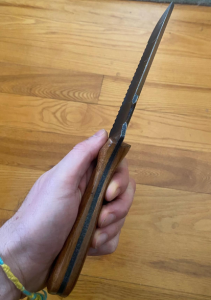 The traditional, venerable Japanese garden knife (or hori hori, derived from the Japanese word for “to dig”) combines the benefits of a sharp edge, a serrated edge, a concave blade for troweling, and construction sturdy enough to hoe and dig out weeds. While there are specialized tools that optimally perform their respective garden tasks, you would be hard-pressed to find a more versatile implement than the hori hori. In my garden, it ostensibly lives on my belt, but in reality, it’s in my hand all the time, often being used in lieu of going and getting that specialized item. And the hori hori has increased in popularity to the point where you will have no trouble locating one online or at your local garden center–my favorite runs about $40.
The traditional, venerable Japanese garden knife (or hori hori, derived from the Japanese word for “to dig”) combines the benefits of a sharp edge, a serrated edge, a concave blade for troweling, and construction sturdy enough to hoe and dig out weeds. While there are specialized tools that optimally perform their respective garden tasks, you would be hard-pressed to find a more versatile implement than the hori hori. In my garden, it ostensibly lives on my belt, but in reality, it’s in my hand all the time, often being used in lieu of going and getting that specialized item. And the hori hori has increased in popularity to the point where you will have no trouble locating one online or at your local garden center–my favorite runs about $40.
Believed to have originated among the indigenous mountain dwellers of ancient Japan, the tool quickly found success as a blade equally adept at rooting out tough mountain vegetation and neatly harvesting fruits and vegetables. Legend suggests that 16th-century emperor Toyotomi Hideyoshi’s attempts to disarm the population by confiscating swords pushed blacksmiths to refocus their skills on designing and producing other implements, which resulted in a dramatic improvement in gardening tools. Moreover, the garden knife was popular, as it was a useful daily tool, but also formidable enough to provide ample self-defense in a pinch, without being subject to imperial confiscation.
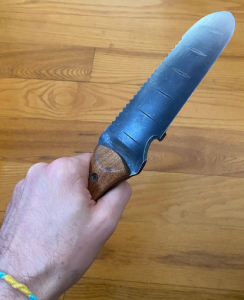 Today, there are myriad versions available on the market. Some people like a plastic or composite handle that can be brightly colored for easy location in a garden bed, while others prefer the more traditional look and feel of wood. There are also multiple styles of forging, including carbon steel and stainless steel, and various lengths and weights allow gardeners to customize what they’re looking for. But a good, true hori hori will have a sharp edge on one side, a serrated one on the other, and a pointed tip. As noted above, many are slightly concave to allow scooping of soil.
Today, there are myriad versions available on the market. Some people like a plastic or composite handle that can be brightly colored for easy location in a garden bed, while others prefer the more traditional look and feel of wood. There are also multiple styles of forging, including carbon steel and stainless steel, and various lengths and weights allow gardeners to customize what they’re looking for. But a good, true hori hori will have a sharp edge on one side, a serrated one on the other, and a pointed tip. As noted above, many are slightly concave to allow scooping of soil.
Two important features you want in your hori hori: a thick, sturdy blade and a full tang (the haft of the blade that fits inside the handle). Every thin-bladed hori hori I’ve used bends under heavy work and a partial tang won’t last, won’t provide the necessary leverage for the heaviest tasks, and/or (worst of all) is simply glued in and will result in a loose or broken handle. The tool shouldn’t be unpleasantly heavy, but it should have obvious heft and feel very sturdy in your hand. You are going to use this tool and you should feel immediately confident it’s up to whatever task you put it to, whether it’s removing a stubborn root, tracing a shallow furrow for seeds, deftly severing the peduncle (the botanical term for a fruit stalk) of a just-ripe tomato, or defending your plot against marauding bandits.
Backyard Bird of the Month: Mourning Dove
By Andy Kapinos, Maine Audubon Field Naturalist

The “mourning” song of the Mourning Dove is one of the first birdsongs many people learn, partly due to the abundance of this species. They are one of the most widespread species in North America and have benefited greatly from human development. These habitat generalists are found everywhere except in extensive wetlands or forests and prefer the patchwork of open habitats commonly found in developed areas. The clearing of much of the Northeast for agriculture created an abundance of both habitat and food for Mourning Doves: they only eat plants, especially seeds. Feeding on the ground, they fill their crop with hundreds of small seeds that are then ground up by small stones (that they also swallow) in their gizzard. Temporarily storing seeds in their crop is also how they feed their young: they regurgitate a nutritious “crop milk” derived from the stored seeds, gradually adding in more seed matter until the young are self-sufficient. Keep an eye out for Mourning Doves carrying sticks in the next couple of months, and you may find them building a nest in your backyard.
For more on the importance of Maine native plants to support birds like the Pine Siskin and other wildlife, visit Maine Audubon’s “Bringing Nature Home” webpage.
Help Stop Invasive Species During National Invasive Species Awareness Week – February 26 – March 3, 2024
Maine Department of Agriculture, Conservation and Forestry
Augusta, Maine – National Invasive Species Awareness Week (NISAW) is being observed from February 26 to March 3, 2024. This annual event aims to educate the public about the threats posed by invasive species and encourages collective action to mitigate their spread.
Here are ten ways individuals can contribute to slowing or preventing the spread of invasive species in Maine:
- Identify Emerald Ash Borer Signs: Learn to recognize emerald ash borer infestation signs, particularly during winter when “blonding” on ash trees is noticeable. Report findings using the EAB Report Form.
- Identify and Remove Invasive Plants: Familiarize yourself with invasive plants like Japanese stiltgrass and vine and volunteer with local land trusts or conservation commissions to remove them from public lands using resources like the Maine Invasive Plant Field Guide.
- Report Tree of heaven Sightings: Be vigilant for the Tree of heaven, which hosts the invasive spotted lanternfly. Report sightings to mnap@maine.gov.
- Combat Browntail Moth: Check hardwood trees and shrubs for browntail moth winter webs and eliminate them before caterpillars become active.
- Prevent the Spread of Invasive Earthworms: Take measures to prevent the spread of invasive earthworms, which disrupt forest soils, by avoiding the movement of plants, soil, mulch, or leaves.
- Use Local Firewood: When camping, avoid transporting firewood to prevent the spread of invasive pests. Purchase firewood locally.
- Practice Play Clean Go: Clean hiking gear, boats, and other equipment to prevent invasive species from spreading to new locations.
- Follow Clean, Drain, Dry: Protect waterways by cleaning, draining, and drying boats and equipment after use. Consider joining organizations like Lake Stewards of Maine for additional involvement.
- Avoid Releasing Exotic Pets: Refrain from releasing aquarium fish, plants, live bait, or exotic animals into the wild. Research and commit to proper care if owning exotic pets.
- Raise Awareness: Spread awareness about invasive species and encourage others to participate in NISAW and related initiatives.
Resources for further engagement include:
- National Invasive Species Awareness Week website
- Participation in related national and local events
- Following Maine Invasive Species Network and Maine Bug Watch
- Exploring Invasive Species Programs run by the State of Maine
By taking collective action and raising awareness, individuals can contribute to protecting Maine’s natural resources from the threats posed by invasive species.
Real-Life Examples of How to Handle Kitchen Scraps
Introduction by Kate Garland, Horticulture Professional
Often the most significant obstacle to establishing a composting routine is the challenge of determining the best indoor workflow. Factors such as space, volume of kitchen scraps, frequency of outdoor disposal, and aesthetics can all play a role in deciding the most successful approach for your home. The crucial factor is that it works for you and those in your household. Here are some real-life examples of how some on our team handle their kitchen scraps all year round.
“I keep a worm bin, have a compost pile (basically just for garden waste) and we send most of our food waste to Scrap Dogs, which is a company that is doing curbside/municipal collection. My favorite tip, as far as vermicomposting goes, is to freeze food scraps before putting in the worm bin which kills fruit fly eggs that might be hiding in food waste. Since I started doing that I haven’t had issues with fruit flies.” — Viña Lindley, Horticulture Professional
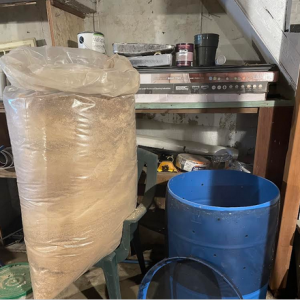 “I use a plastic container on my countertop to collect scraps. In the summer they go directly to the pile outside but in the winter, when I can’t be bothered to shovel a path to the outside pile, I use a 50-gallon barrel in the basement to collect scraps. I cut off the top and lined it with a window screen to make a lid that allowed some airflow. I also drilled holes and covered them with a screen, although I’m not sure those really do much. The key is a giant bag of wood shavings I acquired (you can see it to the left of the blue barrel). I use this to line the bottom of the bin and cover each round of food scraps I add, to absorb moisture and odor. The scraps don’t really break down in the bin (likely because it’s so chilly in my basement) but they hold well and in the spring I dump the whole thing in my compost.” — Rebecca Long, Sustainable Agriculture and Horticulture Professional
“I use a plastic container on my countertop to collect scraps. In the summer they go directly to the pile outside but in the winter, when I can’t be bothered to shovel a path to the outside pile, I use a 50-gallon barrel in the basement to collect scraps. I cut off the top and lined it with a window screen to make a lid that allowed some airflow. I also drilled holes and covered them with a screen, although I’m not sure those really do much. The key is a giant bag of wood shavings I acquired (you can see it to the left of the blue barrel). I use this to line the bottom of the bin and cover each round of food scraps I add, to absorb moisture and odor. The scraps don’t really break down in the bin (likely because it’s so chilly in my basement) but they hold well and in the spring I dump the whole thing in my compost.” — Rebecca Long, Sustainable Agriculture and Horticulture Professional
“I’ve tried various kinds, from fancy gift ceramic ones with activated charcoal filters to a mixing bowl in the fridge with a plate on top all the way to the trusty old Tupperware that sits on your counter full for a week. The real struggle is making the transition from that point to the pile literally as easy as possible in all seasons; otherwise, it becomes a chore that nobody in the house wants to do. Be sure to minimize physical barriers–every door, gate, fence, staircase, etc. between your kitchen and pile disincentivizes.” — Jonathan Foster, Horticulture Outreach Professional.
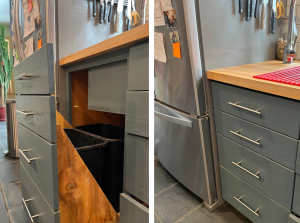 “Our family uses a black plastic bin that’s tucked in a drawer under our counter. The one in front is for compost, and the one in the back is for returnables. It’s not pretty, but it’s out of sight and generally doesn’t have much of an odor (except when broccoli is part of the picture). It gets emptied and rinsed once or twice a week. Being in the woods, I typically use a fallen evergreen branch as a disposable scrub brush before I dump out the rinse water.
“Our family uses a black plastic bin that’s tucked in a drawer under our counter. The one in front is for compost, and the one in the back is for returnables. It’s not pretty, but it’s out of sight and generally doesn’t have much of an odor (except when broccoli is part of the picture). It gets emptied and rinsed once or twice a week. Being in the woods, I typically use a fallen evergreen branch as a disposable scrub brush before I dump out the rinse water.
Additionally, one clever approach I appreciated when I stayed at a rental cabin years ago was to stash kitchen scraps in the freezer in a clearly marked freezer bag. This allowed the owners to encourage renters to responsibly deal with kitchen scraps, but not have it become a “resource” for mice.” — Kate Garland, Horticulture Professional
“We use a stainless, durable, and odor/stain-free compost bucket that Lee Valley makes. They’re not cheap but last for many, many years and stay looking like new. We have the larger 6-liter one and empty it every night, year-round, into a two-bin compost (hand built of hardware cloth with a jointed lid to keep out critters). The only downside is going out to dump it in the bin outside when the path is icy, but otherwise, the process works great.
Stainless steel is THE way to go, given all we’re learning about microplastics and nanoplastics. I’d encourage people to consider a stainless pail WITHOUT any plastic lining. It washes out easily and never stains – so no need for extraneous plastic. And Lee Valley has a 4-liter version for smaller households/camps.” — anonymous Master Gardener Volunteer
No endorsement of products or companies is intended, nor is criticism of unnamed products or companies implied.
UMaine Extension Bulletins
UMaine Extension Videos
- Home Composting Basics (YouTube)
- How to Home Compost: A Compost Recipe (YouTube)
- Worm Composting (YouTube)
Maine Home Garden News Article Curbside Composting Programs
Maine Weather and Climate Overview (March)
Dr. Sean Birkel, Assistant Extension Professor, Maine State Climatologist, Climate Change Institute, Cooperative
Extension University of Maine. For questions about climate and weather, please contact the Maine Climate Office.
NOAA statewide temperature and precipitation data for Maine show that January 2024 was the 12th warmest and had near historical average precipitation for records beginning in 1895. This is in contrast to December 2023, which was 2nd warmest and 4th wettest. Although statewide means from NOAA are not yet available, daily surface observations from Portland, Bangor, and Caribou show February 2024 temperature ranking either 7th, 7th, and 6th warmest, and precipitation ranking 2nd, 1st, and 4th driest, respectively.
Worldwide weather has been influenced by El Niño conditions in the Pacific since June 2023. In December, the El Niño peaked, ranking 5th strongest based on the Oceanic Niño Index for records beginning in 1950. Moderate to strong El Niño events tend to produce winter weather patterns that bring above normal temperature and precipitation to Maine – and this is what we have seen overall this season but with the exception of a dry February. El Niño is the warm phase of the El Niño–Southern Oscillation (ENSO). Current forecasts show El Niño declining until ENSO neutral conditions develop sometime between April and June, after which the system is expected to trend toward La Niña.

NOAA Climate Prediction Center Outlooks
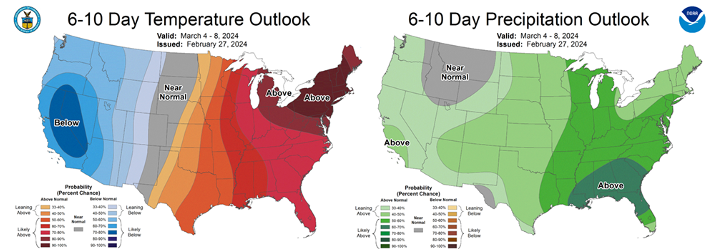
Be sure to check weather.gov for the latest weather forecast in your area. For winter weather updates, visit the National Weather Service Gray and Caribou forecast office webpages. For additional climate information, including historical temperature and precipitation data, visit the Maine Climate Office website.
Do you appreciate the work we are doing?
Consider making a contribution to the Maine Master Gardener Development Fund. Your dollars will support and expand Master Gardener Volunteer community outreach across Maine.
Your feedback is important to us!
We appreciate your feedback and ideas for future Maine Home Garden News topics. We look forward to sharing new information and inspiration in future issues.
Subscribe to Maine Home Garden News
Let us know if you would like to be notified when new issues are posted. To receive e-mail notifications, click on the Subscribe button below.
University of Maine Cooperative Extension’s Maine Home Garden News is designed to equip home gardeners with practical, timely information.
For more information or questions, contact Kate Garland at katherine.garland@maine.edu or 1.800.287.1485 (in Maine).
Visit our Archives to see past issues.
Maine Home Garden News was created in response to a continued increase in requests for information on gardening and includes timely and seasonal tips, as well as research-based articles on all aspects of gardening. Articles are written by UMaine Extension specialists, educators, and horticulture professionals, as well as Master Gardener Volunteers from around Maine. The following staff and volunteer team take great care editing content, designing the web and email platforms, maintaining email lists, and getting hard copies mailed to those who don’t have access to the internet: Abby Zelz*, Annika Schmidt*, Barbara Harrity*, Kate Garland, Mary Michaud, Michelle Snowden, Naomi Jacobs*, Phoebe Call*, and Wendy Robertson.
*Master Gardener Volunteers
Information in this publication is provided purely for educational purposes. No responsibility is assumed for any problems associated with the use of products or services mentioned. No endorsement of products or companies is intended, nor is criticism of unnamed products or companies implied.
© 2023
Call 800.287.0274 (in Maine), or 207.581.3188, for information on publications and program offerings from University of Maine Cooperative Extension, or visit extension.umaine.edu.
